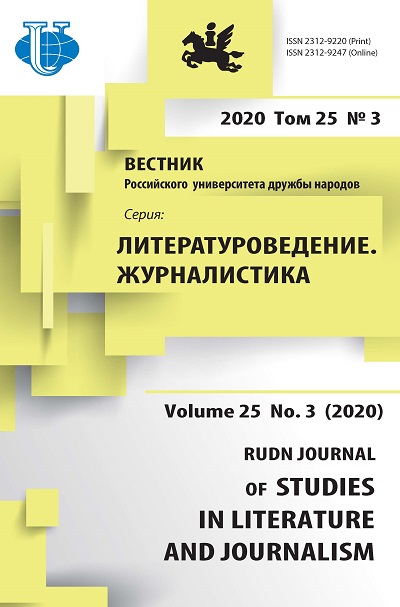Data visualization in Indian print media: a comparative study of English and Hindi newspapers
- Authors: Kumar A.1, Gaur P.2
-
Affiliations:
- Indira Gandhi National Open University
- Amity University, Noida
- Issue: Vol 25, No 3 (2020)
- Pages: 554-566
- Section: JOURNALISM
- URL: https://journals.rudn.ru/literary-criticism/article/view/24831
- DOI: https://doi.org/10.22363/2312-9220-2020-25-3-554-566
Cite item
Full Text
Abstract
The advancing technology is affecting every aspect of life and journalism is also not untouched by this. Due to digitalization, huge amount of data is being generated and the continuous advancement of computer science has made it possible to extract meaningful information by storing and analysing this huge data. The term “data journalism” has become quite popular over the last decade. Analysing data sets, extracting newsworthy information from it and passing it on to the public is data journalism. Data visualization also has a very important place in this whole process. Data visualization is used to communicate information extracted from the data to the users in a clear, interesting and engaging way. The amount of data-based content has started increasing in the news media as well, so the importance of data visualization has also increased. The use of data visualization improves readers’ reading experience and also helps to better understand the data-based content. This preliminary study focuses on the use of data visualizations by English and Hindi newspapers in India. In this research, a comparative study of various aspects of the use of data visualizations in English and Hindi newspapers has been done. Content analysis with quantitative approach has been employed as the research method. This study reveals that there is a big difference in every aspect of the use of data visualizations in English and Hindi newspapers. English newspaper used data visualizations in a better way than their Hindi counterpart.
About the authors
Amit Kumar
Indira Gandhi National Open University
Email: amitkumar@ignou.ac.in
PhD, Assistant Professor at the School of Journalism and New Media Studies (SOJNMS) 93 Maidan Garhi Rd, Maidan Garhi, New Delhi, 110068, Republic of India
Poonam Gaur
Amity University, Noida
Email: pgaur1@amity.edu
PhD, Assistant Professor at the Amity School of Communication (ASCO) Amity Rd, Sector 125, Noida, Uttar Pradesh, 201303, Republic of India
References
- Michailidis, G. (2008). Data visualization through their graph representations. Handbook of data visualization (pp. 103-120). Springer, Berlin, Heidelberg.
- Gray, J., Chambers, L., & Bounegru, L. (2012). The data journalism handbook: How journalists can use data to improve the news. O'Reilly Media, Inc.
- Uskali, T.I., & Kuutti, H. (2015). Models and streams of data journalism. The Journal of Media Innovations, 2(1), 77-88.
- RNI. (2019). Press in India 2017-2018. Retrieved January 12, 2020, from http:// rni.nic.in/pdf_file/PIN2017-18/CONTENTS.pdf
- Department of Official Language. (2020). Languages Included in the Eighth Schedule of the Indian Constitution. Retrieved April 1, 2020, from https://rajbhasha.gov.in/en/ languages-included-eighth-schedule-indian-constitution
- Kumar, A. (2014). The Jan Lokpal Andolan and alternate politics: Symbiotic interactions, vernacular publics, and news media in the Jan Lokpal Andolan. Democratic Transformation and the Vernacular Public Arena in India (pp. 111-128). Routledge.
- Joseph, M. (2011, February 16). India Faces a Linguistic Truth: English Spoken Here. Retrieved October 25, 2019, from https://www.nytimes.com/2011/02/17/world/asia/ 17iht-letter17.html
- Arthur, C. (2010). Journalists of the future need data skills, says Berners-Lee. Retrieved February 1, 2020, from https://www.theguardian.com/technology/organgrinder/ 2010/nov/19/berners-lee-journalism-data
- Glover, A., & Beard, D. (2017, September 18). Study shows data reporting gaining hold in newsrooms. Retrieved February 3, 2020, from https://www.poynter.org/tech-tools/2017/study-shows-data-reporting-gaining-hold-in-newsrooms/
- Kirk, A. (2016). Data visualisation: A handbook for data driven design. Sage.
- Weber, W., Engebretsen, M., & Kennedy, H. (2018). Data stories: rethinking journalistic storytelling in the context of data journalism. Studies in Communication Sciences, 2018(1), 191-206.
- Lorenz, M. (n.d.). Why Journalists Should Use Data. Retrieved March 2, 2020, from https://datajournalism.com/read/handbook/one/introduction/why-journalists-should-use-data
- Stalph, F. (2018). Classifying Data Journalism: A content analysis of daily data-driven stories. Journalism Practice, 12(10), 1332-1350. doi: 10.1080/17512786.2017.1386583
- Loosen, W., Reimer, J., & De Silva-Schmidt, F. (2017). Data-driven reporting: An on-going (r)evolution? An analysis of projects nominated for the Data Journalism Awards 2013-2016. Journalism, 1464884917735691.
- Young, M.L., Hermida, A., & Fulda, J. (2018). What makes for great data journalism? A content analysis of data journalism awards finalists 2012-2015. Journalism Practice, 12(1), 115-135.
- Krippendorff, K. (1980). Content Analysis: An Introduction to Its Methodology. Newbury Park, CA, Sage.
- Berelson, B. (1952). Content analysis in communication research. Glencoe, IL, Free Press.
- Wimmer, R.D., & Dominick, J.R. (2011). Mass media research: An Introduction. Boston, Wadsworth Cengage Learning.
- Riffe, D., Aust, C.F., & Lacy, S.R. (1993). The Effectiveness of Random, Consecutive Day and Constructed Week Sampling in Newspaper Content Analysis. Journalism Quaterly, 70(1), 133-139. Retrieved January 21, 2020, from http://www.aejmc.org/home/ wp-content/uploads/2012/09/Journalism-Quarterly-1993-RiffeAustLacy-133-391.pdf
- Hester, J.B., & Dougall, E. (2007). The efficiency of constructed week sampling for content analysis of online news. Journalism & Mass Communication Quarterly, 84(4), 811-824.
- John, B.K. (2015, August 19). Hijacking the front page. Retrieved March 2, 2020, from http://asu.thehoot.org/opinion/hijacking-the-front-page-8872
















